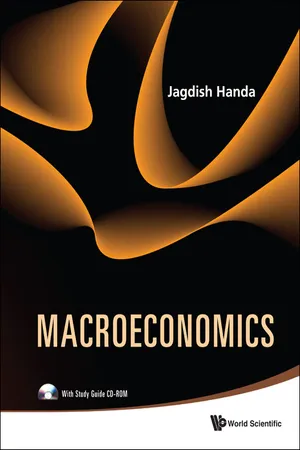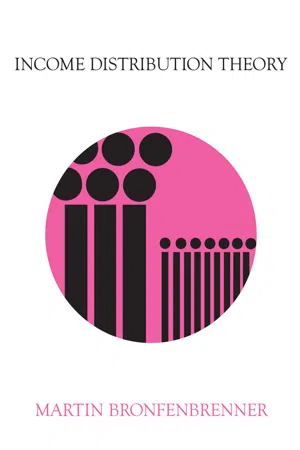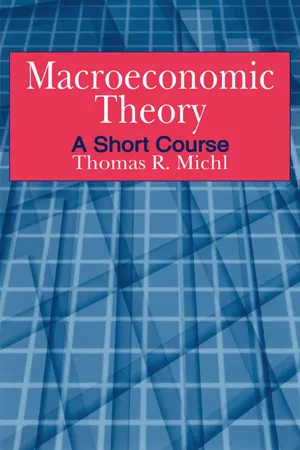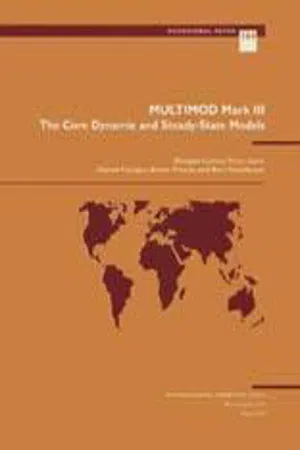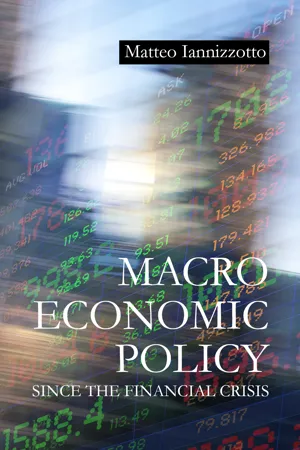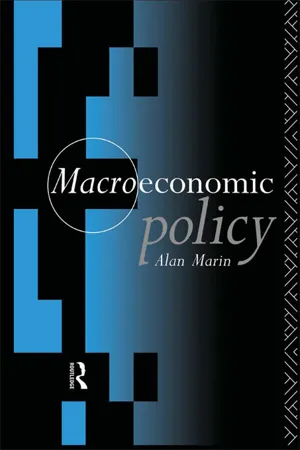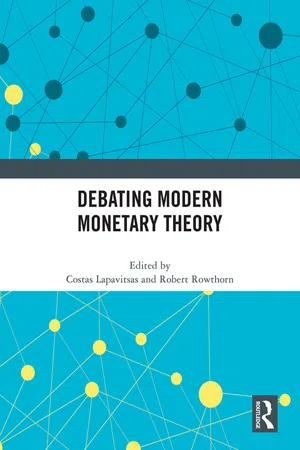Economics
Short-Run Phillips Curve
The Short-Run Phillips Curve illustrates the inverse relationship between inflation and unemployment in the short term. It suggests that as unemployment decreases, inflation tends to rise, and vice versa. This concept is important for understanding the trade-off between inflation and unemployment and has implications for monetary policy.
Written by Perlego with AI-assistance
Related key terms
Related key terms
1 of 4
Related key terms
1 of 3
12 Key excerpts on "Short-Run Phillips Curve"
- eBook - ePub
Money and Banking
An International Text
- Robert Eyler(Author)
- 2009(Publication Date)
- Routledge(Publisher)
Figure 10.2 shows the short-run version of this curve; Equation 10.2 shows the Phillips Curve in a mathematical form. The downward slope represents the inverse relationship and the opportunity cost of pursuing lower inflation or unemployment as an explicit goal of monetary policy.(10.2) Figure 10.2 The Short-Run Phillips Curve.Equation 10.2 shows the relationship between unemployment and expected inflation, where the difference between the current unemployment rate and the natural rate of unemployment determines the amount of expected inflation, including a positive trend and error.6 The parameter represents the sensitivity of expected inflation to a marginal difference in current unemployment from the natural rate; > 0. The larger the value of , the more sensitive the relationship is between unemployment and inflation (steeper Phillips Curve); the less positive ’s value is, the flatter the Phillips Curve and the less sensitive inflation expectations are to changes in unemployment.The transmission mechanism discussed earlier helps understand how sensitive expectations can be. Suppose expansionary monetary policy took place. The relationship between the change in unemployment and the subsequent inflation would depend on how fast both firms and workers reacted to the new policy. The faster both sides react to new inflation expectations, the steeper the Phillips Curve should be. Notice there is no mention of unemployment expectations, only prices. This idea connects back to aggregate demand: when monetary policy changes, aggregate demand changes and creates incentives for more production or real GDP. The fact that more employment (less unemployment) is a result of monetary expansion is not debated, i.e. the aggregate supply curve is either flat or upward-sloping when the economy is not in full employment. Whether it is flat or upward-sloping depends on how workers and firms react to their price expectations. - eBook - ePub
Macroeconomics
(With Study Guide CD-ROM)
- Jagdish Handa(Author)
- 2010(Publication Date)
- WSPC(Publisher)
Figure 10.3b .10.10 Phillips Curve (PC)In 1958, A.W. Phillips plotted the rate of change of nominal wages against the rate of unemployment for the U.K. over several periods from 1861 to 1957, and found that the data showed a downward sloping curve. His original plotted relationship was of the formwhere W″ is the rate of increase of the nominal wage rate, u is the actual rate of unemployment, and dW′/du 0 indicates that the rate of increase of nominal wages falls as unemployment rises. This occurs because a higher unemployment rate weakens workers’ bargaining power relative to that of firms. Therefore, the unemployment-wage relationship is of the form shown in Figure 10.3a , which has the rate of change in nominal wages W ″ on the vertical axis and the actual rate of unemployment u on the horizontal one. The estimated forms of this curve proved to be convex to the origin, i.e., decreases in unemployment cause successively greater increases in nominal wages.19 This relationship soon evolved into its inverse — that is, u = f(W″) — and then into a relationship of the formwhere π is the rate of inflation and du/dπ 0. This equation is called the Phillips curve (PC) equation and is drawn as the curve PC in Figure 10.3b , with the rate of inflation π on the vertical axis. The PC states that increases in the inflation rate reduce the unemployment rate. Its convex shape indicates that at higher inflation rates, further increases in inflation produce smaller decreases in unemployment.The transition between the above two equations comes from the link between the nominal wage rate and inflation: nominal wages represent the main element of the cost of production so that an increase in nominal wages will induce firms to increase their prices; alternatively, an increase in prices causes labor to ask for compensation in the form of wage increases. Hence, there is a positive relationship between W″ - eBook - ePub
Macrodynamics: Fluctuations and Growth
A study of the economy in equilibrium and disequilibrium
- Pierre-Yves Hénin(Author)
- 2013(Publication Date)
- Routledge(Publisher)
22 The coefficient a expresses the proportion of anticipated inflation incorporated into the current rate of growth of prices and wages. A more comprehensive analysis of the ‘expectations-augmented’ Phillips curve requires some explanation of the process of expectations formation. The above expression is valid in the short term for a given anticipated inflation rate, while in the long term it is assumed that expectations are realised, so thatThe gradient of the long-run Phillips curve is greater than that for the short run, which implies that the cost in terms of inflation of reducing unemployment is increased. In the limit, with absence of money illusion and full carry-through of anticipated inflation, the coefficient α equals one, and the Phillips curve is vertical. It is then no longer possible to obtain a permanent reduction in unemployment by allowing a higher level of inflation.Figure 11.9Figure 11.10There exists a family of Short-Run Phillips Curves, whose level is a function of anticipated inflation and which in the long term, with endogenous, equal to the actual inflation rate, gives way to a vertical line. The unemployment rate unis then compatible with any rate of inflation. If it be allowed that anticipated inflation follows actual inflation with some degree of inertia, the accelerationist theory may be established. The simplest expectations formation process which includes such inertia is the static process , for which the augmented Phillips curve, while maintaining the assumption of absence of money illusion, becomes:The trade-off is now no longer between unemployment and inflation, but between unemployment and the acceleration of inflation, whence the name ‘accelerationist’ given to this theoretical approach.23The only rate of unemployment consistent with a constant inflation rate is uandn, called by Friedman the ‘natural rate’ of unemployment. Defining a function h over the gaps , between the current unemployment rate and the natural rate, we have:The first expression, general for α - eBook - ePub
Inflation Dynamic
Global Positive Economic Analysis
- Weshah Razzak(Author)
- 2023(Publication Date)
- Routledge(Publisher)
8 The Phillips Curve, Anticipated Inflation, and OutputDOI: 10.4324/9781003382218-8Abstract
We discuss the evolution of and the theoretical issues surrounding the Phillips curve, which was originally (Phillips, 1958 ) a negative empirical relationship between the unemployment rate and the inflation rate. It has been the dominant theory of inflation in central banks in developed countries. Policymakers and politicians seem to like the idea that they could influence the economy by exploiting this relationship, that is, in order to create more employment, they inflate the economy. By late 1960s and through the 1970s, more theoretical analyses showed that such exploitation is fruitless because unanticipated aggregate demand shocks, that is, surprises, ignored by Phillips, is the only significant determinant of real output. Anticipated aggregate demand shocks, on the other hand, are ineffective in stimulating the economy. Every time the monetary authority attempts to stimulate demand, it increases real output (reduces unemployment) in the short run, then inflation expectations shift up the Phillips curve, and real output (unemployment) returns to their long-run equilibrium before the policy change. If the monetary authority continues to stimulate the economy, the Phillips curve keeps shifting up via expectations effects, and, in the long-run, the economy ends up with more inflation and no change in real output or unemployment; hence the Phillips curve is vertical in the long run, and no trade-off between inflation and output (unemployment) exists. Our Sample Generalized Variance tests indicate that the New Keynesian specification, change in inflation–output gap, is unstable in most of the 42 countries in our sample.Monetary theories of inflation are contentious. There are stark differences of opinions between economists about the determinants of inflation. So far, we have only analyzed the QTM, where in the long run, inflation is caused by, or is highly correlated with, the growth rate of the quantity of money per unit of real output. Remember that we define inflation as a continuing increase in the price level, and the difference between the short run on one hand and the long run - eBook - ePub
- Martin Bronfenbrenner(Author)
- 2017(Publication Date)
- Routledge(Publisher)
Chapter 10 , section 14.Such an inverse relation as the Phillips curve is plausible on grounds of either economic theory or bargaining theory. We introduced it in Chapter 10 as an aspect of the incidence of collective bargaining. However, for any commodity x with price p = f (x ) in a purely competitive market, the Samuelson condition of dynamic stability of the relationship f (x ) is thatwhere t is time, λ is a positive constant, andExis the excess demand for x (quantity demanded less quantity supplied) at price p .If we rewrite the last expression in terms of a wage rate w and a quantity of labor a , and introduce a positive technical improvement or productivity increase factorw0:LetEabe the excess demand for either some special sort of “standard” labor or for “standard” labor in the aggregate. Even so, the conditionEa= 0 is consistent with considerable unemployment of substandard labor (uneducated, inexperienced, handicapped, subject to discrimination). It is therefore consistent also with a positive measured unemployment rate, especially if no allowance is made for unfilled job vacancies. The measured unemployment rate also include the “frictional” unemployment of workers changing jobs.On a diagram like Figure 11.6 (redrawn from Figure 10.3 ), the horizontal line A may serve as an estimate ofw0, withEa= 0. It also represents the annual rise in average and marginal labor productivity, and hence the maximum wage increase consistent with price stability in the absence of functional income redistribution in favor of labor. The vertical line B , it will be remembered, is the maximum “politically feasible” unemployment level, and F is the intersection of the A and B lines. The P 0 andPxfunctions of Figure 10.3 are two-dimensional31 Phillips curves and serve as estimates of w in (11.5) - eBook - ePub
Macroeconomic Theory: A Short Course
A Short Course
- Thomas R. Michl(Author)
- 2015(Publication Date)
- Routledge(Publisher)
10.5: Starting from a long-run equilibrium (A), an increase in the rate of growth of the money supply from 5 per cent per year to 6 per cent per year causes the system to move along its Phillips curve in the short run (B). Because inflation expectations chase after actual inflation, next year’s equilibrium lies on the new Phillips curve (C). Ultimately, the system will achieve the new long-run equilibrium (D). The arrow shows the path taken when the model has a stable focus, which involves overshooting the equilibrium.In its first period, the policy moves the economy along its existing Phillips curve. Since workers follow adaptive expectations, they believe that the inflation rate will remain at its original level (the old long-run equilibrium inflation rate).In its second period, the policy works through both dynamic processes we described above. The Phillips curve shifts upward because the expected rate of inflation, which positions the Phillips curve, chases after the actual rate of inflation, which rose in the first year. The unemployment rate in Figure 10.5 has continued to decline, because the inflation rate is still below the new growth rate of the money supply set by the central bank.At some point in time, the economy will reach a turning point where the unemployment rate will cease dropping and begin to rise. This will occur when the inflation rate rises above the growth rate of the money supply. The Phillips curve will then be shifting upward and the unemployment rate will be rising, so that inflation and unemployment increase simultaneously, a phenomenon known as stagflation. The ability of the expectations-augmented Phillips curve to explain the stagflation of the 1970s played a major role in its acceptance by the economics profession.Another turning point is reached when the unemployment rate rises above the natural rate of unemployment. As we have seen, in this configuration the Phillips curve shifts downward over time because inflation expectations overestimate inflation, and are being revised downward. The economy experiences falling inflation and rising unemployment until the next turning point is reached. - Hamid Faruqee, Douglas Laxton, Bart Turtelboom, Peter Isard, and Eswar Prasad(Authors)
- 1998(Publication Date)
- INTERNATIONAL MONETARY FUND(Publisher)
50Passage contains an image
Specification of the Mark III Phillips Curve
The Phillips curve in Mark III follows closely on the heels of some recent empirical work that has extended an estimation methodology proposed in Debelle and Laxton (1997 ) and applied to a fairly large group of industrial countries.51 The empirical strategy is based on developing model-consistent measures of labor market tightness from the following convex functional form:where u is the unemployment rate, u * is the DNAIRU, and γ and φ are parameters to be estimated.52 Box 6 follows Faruqee, Laxton, and Rose (1998 ) in providing a derivation of the convex Phillips curve that is based on extending the model of Layard, Nickell, and Jackman (1991 ).The Phillips curve represented by equation (8) has two asymptotes, at u = φ and π − πe = −γ, as shown in Figure 1 . The first represents the minimum level of unemployment where the Short-Run Phillips Curve becomes vertical. The second asymptote, −γ, represents the point where marginal increases in unemployment have no additional downward effects on the inflation process. This is the region of extreme diminishing marginal effectiveness where a marginal tightening of macroeconomic policies mainly affects unemployment with little impact on the inflation process.One can think of the NAIRU, or in Figure 1 , as Friedman's (1968 ) concept of the “natural” rate, on the grounds that, for given institutions and stabilization policy rules, this is the rate that is “ground out” on average by markets. It may be noted, as well, that data observed in a stochastic world do not yield direct estimates of the DNAIRU, u- eBook - ePub
- Matteo Iannizzotto(Author)
- 2023(Publication Date)
- Agenda Publishing(Publisher)
3 Behind the three equations II: inflation and the Phillips curve3.1 Inflation and the Phillips curveIt must be remembered that the Phillips curve is first and foremost an empirical relationship that was originally meant to relate wage inflation and unemployment (Phillips 1958 ). Ever since it has been in search of a theoretical justification that has come in different guises and sometimes these have also been radically different. In the context of the three-equations model (or the DSGE) it is meant to represent the behaviour of inflation relative to some measure of the output gap. Stripped of all deeper theoretical foundations, that is its bare purpose. Inevitably, when one examines what lies behind it, one is forced to examine inflation per se. It is in the treatment of this crucial economic variable and the Phillips curve that purports to represent it, that the greatest and deepest discrepancies will be found between the three-equations model and the DSGE. But in order to see this in greater detail, some general questions about inflation will have to be addressed.In its barest form, inflation just means a positive rate of growth in prices. How it comes about and what justifies it can be done in different ways. In particular a general distinction can be made between demand-pull and cost-push inflation. The first case, in intuitive terms is when demand outstrips supply and prices have to rise. Another way of looking at it is to say that it is a case of excess demand. These instances have already been represented in the diagrams of the first chapter in all the cases where the first shock was one on the IS curve (permanent or temporary) making it true that current output would exceed equilibrium (or otherwise put, the output gap is positive). Consistently with the specification of the Phillips curve, the positive output gap on the right-hand side causes inflation to rise on the left-hand side.1 - eBook - ePub
Defensive Expectations
Reinventing the Phillips Curve as a Policy Mix
- Liviu Voinea(Author)
- 2020(Publication Date)
- Palgrave Macmillan(Publisher)
Moreover, it lost its statistical significance after the Great Recession (Table 1.2). Fig. 1.2 The Phillips Curve for OECD countries: output gap versus inflation rate, 1990–2018. (Source: author’s calculations, based on OECD data, 2020) Table 1.2 The Phillips Curve for OECD countries: output gap versus inflation rate, estimation results, 1990–2018 Slope R-squared No. of observations Output gap—inflation rate 1990–2000 0.221*** 0.579 285 2001–2010 0.2189*** 0.483 350 2011–2018 0.049 0.302 280 Notes: Panel estimations with country fixed effects; significance level of 1% (***), 5% (**) and 10% (*) Source: Author’s calculations, based on OECD data The Phillips Curve remains, of course, country-dependent and data-dependent. Yet, overall, it cannot be denied that the slope has become less and less steep to the point where it is almost completely horizontal. A short-term quasi-horizontal Phillips Curve means a loss of significance for the impact of economic slack on inflation. While the theory tells us that the long-term Phillips Curve is a vertical line, the data shows us that in the last decades the Short-Run Phillips Curve has been a quasi-horizontal line. The most widely accepted argument for this apparently diminished relevance of the Phillips Curve is the central banks’ achievements in taming inflation expectations. In other words, central banks are the victims of their own success. The proof of their success lies in anchoring inflation expectations at a lower level than in the past. At a Brookings Conference in 2019, 19 Ben Bernanke, the former Chair of the Federal Reserve, strongly affirmed that increased inflation anchoring was the most important structural change in monetary policy over the last decades. This could explain, he argued, both the missing disinflation from 2009 to 2011 and the missing inflation afterward - eBook - ePub
- Alan Marin(Author)
- 2005(Publication Date)
- Routledge(Publisher)
It is important to note that, as stressed in the original Lipsey approach, we do not have direct measurements of the demand and supply of labour schedules and therefore cannot directly observe the level of unemployment at which the demand and supply of labour are equal. Hence estimates of the natural rate are usually obtained indirectly by econometrically estimating an expectations augmented Phillips Curve and then using the estimated curve to see at which level of unemployment inflation would be steady. If it is found that the natural rate varies, it is always possible to provide some justification, but the feeling remains amongst some critics that the procedure is ad hoc. 43 Even according to what is probably the majority view, which accepts the empirical validity of the expectations augmented Phillips Curve, the policy implications are not necessarily as straightforward as suggested by the above 1976 quote by the UK Prime Minister. As put by those who feel that the Vertical Phillips Curve’ rules out any attempt to reduce unemployment by macroeconomic policy (as opposed to microeconomic policies to shift the natural rate), it would seem that any such attempt will lead simply to higher inflation without any benefit to employment and output. However, the speed with which inflation rises depends on two factors: (i) the slope of the Short-Run Phillips Curve; (ii) the speed with which expectations of inflation alter. If the Short-Run Phillips Curve is relatively flat, then an expansionary monetary/fiscal policy will have relatively little immediate impact on the rate of wage increases. If expectations of future inflation adapt only very sluggishly to actual inflation, then the Short-Run Phillips Curve will not quickly shift up very far. Thus the mere existence of an expectations augmented Phillips Curve does not in itself mean that runaway inflation will soon result from any attempt to reduce inflation - eBook - ePub
- Costas Lapavitsas, Robert Rowthorn, Costas Lapavitsas, Robert Rowthorn(Authors)
- 2022(Publication Date)
- Routledge(Publisher)
The latter introduced the Expectations-Augmented Phillips Curve (EAPC), which spearheaded the resurgence of pre-Keynesian macroeconomic thinking in the form of Monetarism. The natural rate of unemployment (NRU) concept became central to the idea that the tradeoff between inflation and unemployment, captured in the Phillips curve, was in fact a tradeoff between unemployment and unexpected inflation. Once expectations are realized as workers gain more information, the tradeoff vanishes. At this point there is only one unemployment rate consistent with stable inflation—the NRU, later the Non-Accelerating Inflation Rate of Unemployment (NAIRU) (Modigliani and Papademos 1975). The expectations-augmented Phillips curve led to the New Classical representation incorporating rational expectations, which cast price misperceptions as random variables and concludes that any observed tradeoffs arise because of random shocks, which are beyond the scope of policy (for example, Lucas 1972 ; Sargent, Fand, and Goldfeld 1973). It is invalid to interpret this sequence of ideas as a consistent development of a paradigm with increasing theoretical and empirical content. The 1958 version of the Phillips curve and its subsequent Keynesian variants were based on a disequilibrium notion where prices and wages adjust to some labor market imbalance between supply and demand. There is no presumption that full employment is inevitable or a natural tendency of a capitalist monetary economy. In contradistinction, the EAPC and later developments gained motivation from Fisher (1926) who worked within a market-clearing framework. These developments represent a major break from Phillips (1958) because the causality is reversed. Unemployment is considered to be the voluntary outcome of optimizing choices by individuals between work (bad) and leisure (good). Full employment is assumed to prevail (unemployment at the natural rate) unless there are errors in interpreting price signals - eBook - ePub
Economics of Transition
A New Methodology for Transforming a Socialist Economy to a Market-led Economy
- Hüsnü Kizilylli(Author)
- 2019(Publication Date)
- Routledge(Publisher)
Similarly when an unanticipated decline in aggregate demand occurs and real prices and wages increase unexpectedly and as a consequence a temporary surplus of labor and goods emerges, a rational firm, in lieu of reducing output and laying off redundant workers (which is a costly and painful exercise itself), would rather reduce its prices which would restore demand and to tackle with the reduced profit margin due to high wage costs, could renegotiate wages and workers, under the threat of losing their jobs would rather accept lower wages, as they did in the early 1980s in the US. Or the firm after lowering its prices could well decide to absorb the extra wage cost element, depending on circumstances, in order to keep its market share, and considering also that it will re-hire the same workers when real wages decline to their normal level. The firm might take this opportunity to get rid of inefficient workers, but then it will shortly have to restore employment and output.Moreover reducing output and employment in the face of unanticipated demand fall assumes closed economy and no competition in oligopolistic markets, whereas even colluding oligopolistic firms would undercut competitors when opportunities arise. This situation gives a good opportunity to do so, particularly for the firm which successfully re-negotiated the new wage level. In an open economy, overpriced products would invite foreign competition and import penetration into the market will increase and a rational firm has to protect its market share against such eventuality.6 Empirical evidence for the Phillips curve trade-off
Empirical evidence showing that in the short-run an increase in the money stock affects primarily output and has little effect on inflation (prices or wages) is considered as solid support for the short-term Phillips curve. E.g. the Data Resources Inc. macroeconometric model for the US economy shows that 0.5% monetary expansion (in real balances) would at the beginning cause output to rise with almost no impact on prices; “only after a year does output start falling back as prices increases build up and bring real balances back down: but even after 16 quarters or 4 years, output is still above its initial level and prices have not risen by a full percentage point”. This is considered as empirical evidence for the Phillips curve trade-off, since due to gradual adjustment of wages (sticky wages), a monetary expansion had a lasting effect on output and employment (Dornbusch and Fischer, 1990, pp. 480-81). Following comments can be made on these views:
Index pages curate the most relevant extracts from our library of academic textbooks. They’ve been created using an in-house natural language model (NLM), each adding context and meaning to key research topics.
Explore more topic indexes
Explore more topic indexes
1 of 6
Explore more topic indexes
1 of 4

